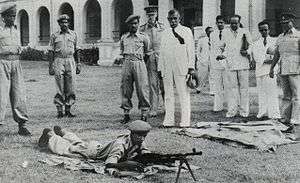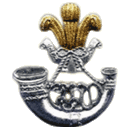Sri Lanka Light Infantry
| Sri Lanka Light Infantry | |
|---|---|
|
Cap badge of the Sri Lanka Light Infantry | |
| Active | 1 April 1881 – Present |
| Country | Sri Lanka |
| Branch | Sri Lanka Army |
| Type | Light Infantry |
| Role | Infantry/Light Role |
| Size |
15 regular battalions, 8 volunteer battalions,1 RFT battalion |
| Regimental Headquarters | Panagoda Cantonment, Panagoda. |
| Nickname(s) | SLLI |
| Motto(s) | "Ich Dien" German – (I serve). |
| Colors | Red and Blue |
| March | "I am Ninety Five" |
| Mascot(s) | Kandula |
| Anniversaries | 1 April |
| Engagements |
Second Boer War World War I World War II 1971 Insurrection Insurrection 1987-89 Sri Lankan Civil War United Nations Stabilization Mission in Haiti |
| Decorations | 1 Parama Weera Vibhushanaya |
| Commanders | |
| Centre Commandant | Col K.J Jayaweera RSP |
| Colonel of the Regiment | Major General Amal Karunasekara RWP RSP USP ndu psc |
| Notable commanders | Gen. Sir John Kotelawala, KBE, CH |
| Insignia | |
| Identification symbol | "LIGHT INFANTRY" shoulder tab |
The Sri Lanka Light Infantry (SLLI) is the oldest regiment in the Sri Lanka Army and the oldest infantry regiment in the army. It is made up of ten regular battalions and five volunteer battalions, and is headquartered at the Panagoda Cantonment, Panagoda. Over the years it has become the most distinguished and dependable regiment in the army.
History
The regiment's origins can be traced back to the formation of the Ceylon Light Infantry Volunteers (CLIV) force which was formed on 1 April 1881 by a proclamation issued by the Governor of Ceylon as a reserve unit in Ceylon. The first commanding officer of the force was Lieutenant Colonel John Scott Armitage and the Colonel of the Regiment was HRH Albert Edward, the Prince of Wales. The regiment's current Regimental March I am Ninety Five and the Regimental Bugle Call were adopted soon after this. In the same year, HRH the Prince of Wales accepted the Honorary Colonelcy of the Ceylon Light Infantry Volunteers, and the unit adopted his crest and motto as its badge. In 1892, a mounted infantry company was formed and later it became a regiment of its own by the name of the Ceylon Mounted Rifles.
The Ceylon Light Infantry Volunteer force troops were sent to South Africa in 1900, where they took part in the Second Boer War. As a result of their service, the force was awarded a Banner from HRH The Duke of York. In 1902, King Edward VII became the Colonel-in-Chief.
In 1910, after the formation of the Ceylon Defence Force, the CLIV became a part of it and was renamed the Ceylon Light Infantry. The regiment saw action during World War I along with allied troops. Soon after the war a regular element of the regiment was formed to take up garrison duties in Ceylon. This unit was named the Mobilised Detachment of Ceylon Light Infantry (Mob. Det., CLI). The regiment was again mobilized during World War II and was deployed in the Seychelles and the Cocos Islands.

Ceylon gained its independence from Britain in 1948 and after the Army Act of 1949 was passed the CLI became the Ceylon Infantry Regiment and came under the newly formed Ceylon Army. In 1950, the regiment was reorganized, with two battalions being formed: the 1st Battalion, The Ceylon Light Infantry, became a regular unit and the Volunteer Battalion was re-designated as the 2nd (Volunteer) Battalion, Ceylon Light Infantry.
The regiment was deployed for counter insurgency operations in during the 1971 Insurrection and in 1972, when Sri Lanka became a republic, the regiment changed its name to Sri Lanka Light Infantry. Since the early 1980s units of the regiment have been deployed to the northern parts of the island. After being deployed, a patrol from the 1st Battalion's 'C' Company – designated Four Four Bravo – was ambushed, marking the beginning of the Sri Lanka civil war. Since then the SLLI has been deployed on combat operations throughout the island and has expanded a total of 15 battalions.
The regiment also took part in the United Nations Stabilization Mission in Haiti in 2003.[1][2]
Cadet battalion
In 1881, a cadet platoon was formed at the Royal College, Colombo, attached to the CLI. This was eventually expanded to become the Cadet Battalion, Ceylon Light Infantry under the Ceylon Defence Force. Later this unit became the Ceylon Cadet Corps, which is now known as the National Cadet Corps.
Regimental colours
The regimental colours were awarded in 1921 and on 22 March 1922 the Ceylon Light Infantry was awarded with the King's and the Regimental Colours. When the regular 1st Battalion was formed in 1949, HM Queen Elizabeth II presented the new colours to the battalion. The Queens and Regimental Colours were presented to the 1st Battalion on 21 April 1954. With the declaration of the Republic of Sri Lanka, the colours were laid to rest within the regimental museum on 29 June 1974.[3] On 10 October 1978, H.E. President J.R. Jayawardena awarded President's and Regimental Colours to both the 1st and 2nd Battalions.
Regimental insignia
In the early stages of the regiment's history, from March 1881 to 28 November 1881, the volunteer corps used an elephant and a coconut tree as their emblem.[4] With the declaration of the Republic of Sri Lanka the regiment's 1st and 2nd Battalions decided to retain as much of the configuration and pattern of the badge as possible, although a new insignia was introduced consisting of a silver bugle horn bound in brass to represent the regiment's role as a light infantry unit, and three paddy sheaves to signify prosperity. It also retained the motto of the Prince of Wales ICH DIEN, which was adopted as the motto of the regiment in its translated form I SERVE.[4]
Units
Regular battalions
- 1st Sri Lanka Light Infantry
- 4th Sri Lanka Light Infantry
- 6th Sri Lanka Light Infantry
- 7th Sri Lanka Light Infantry
- 8th Sri Lanka Light Infantry
- 10th Sri Lanka Light Infantry
- 11th Sri Lanka Light Infantry
- 12th Sri Lanka Light Infantry
- 15th Sri Lanka Light Infantry
- 19th Sri Lanka Light Infantry
- 20th Sri Lanka Light Infantry
- 23rd Sri Lanka Light Infantry
- 24th Sri Lanka Light Infantry
- 25th Sri Lanka Light Infantry
- 26th Sri Lanka Light Infantry
- RHQ Battalian Sri Lanka Light Infantry (RFT)
Volunteer battalions
- 2nd (V) Sri Lanka Light Infantry
- 5th (V) Sri Lanka Light Infantry
- 9th (V) Sri Lanka Light Infantry
- 14th (V) Sri Lanka Light Infantry
- 16th (V) Sri Lanka Light Infantry
- 17th (V) Sri Lanka Light Infantry
- 18th (V) Sri Lanka Light Infantry
- 21st (V) Sri Lanka Light Infantry
Deployments
- Second Boer War
- World War I
- Home defence
- Western front
- World War II
- Home defence
- Seychelles
- Cocos Islands
- 1971 Insurrection
- Insurrection 1987-89
- Sri Lankan Civil War
- United Nations Stabilization Mission in Haiti
Recipients of the Parama Weera Vibhushanaya
Notable members
- General Sir John Lionel Kotelawala, CH, KBE – Former Prime Minister of Ceylon
- General D. S. Attygalle, MVO – Former Commander of the Sri Lankan Army
- General T. I. Weerathunga, VSV, ndc – former Commander of the Sri Lankan Army and Chief of the Defence Staff
- General Shantha Kottegoda, WWV, RWP, RSP, VSP, ndc -Former Commander of the Sri Lankan Army
- Major General Anton Muttukumaru, OBE, ED – First Ceylonese Commander of the Ceylon Army
- Major General B.R. Heyn – Former Commander of the Ceylon Army
- Major General A.R. Udugama, MBE – Former Commander of the Ceylon Army
- Justice Eugene Wilfred Jayewardene – Judge of the Supreme Court of Ceylon
- Major General T.T. Ranjith de Silva, RWP, RSP, USP, PSC – Former Security Forces Commander – Eastern Province and Government Agent, Trincomalee District
- Major General Nanda Mallawaarachchi, RWP, VSV, USP, ndc, psc – Former Chief of Staff of the Sri Lankan Army and present Sri Lankan Ambassador to Indonesia
- Major General Lakshman 'Lucky' Wijayaratne † RWP, RSP – Former brigade commander, 22 Brigade[5]
- Colonel T G Jayewardene – First Ceylonese commanding officer and former member of the State Council of Ceylon
- Colonel Waldo Sansoni, OBE, VD, JP, UM – Colonel commanding, Ceylon Light Infantry (1935–1939)
- Lieutenant Colonel Angelo Peiris, RWP, RSP † – Leader of the first wave of the seaborne landing during Operation Balavegaya
- Lieutenant Colonel Dhananjaya Weerabahu Wijesinghe, RSP † – 2nd Commander – 7th Sri Lanka Light Infantry during the Third Eelam War
- Major Bevis Bawa, ADC, CLI - former Aide-de-camp to the Governor of Ceylon
- Major General Amal Karunasekara, RSP, USP, ndu, psc, MSc - current COLONEL OF THE REGIMENT [6]
- Major General Piyal Abeysekera (also known as E P De Z Abeysekera) USP, MSc - former Deputy Chief of Staff of Sri Lanka Army
Order of precedence
| Preceded by Sri Lanka Signals Corps |
Order of Precedence | Succeeded by Sri Lanka Sinha Regiment |
See also
References
- ↑ Sri Lanka Light Infantry
- ↑ Haiti – MINUSTAH – Facts and Figures, United Nations Stabilization Mission in Haiti
- ↑ REGIMENTAL INSIGNIA,THE COLOURS OF THE REGIMENT, www.army.lk/lightinfan.php
- 1 2 REGIMENTAL INSIGNIA,INTRODUCTION OF THE REGIMENTAL INSIGNIA, www.army.lk/lightinfan.php
- ↑ Major General Lakshman 'Lucky' Wijayaratne
- ↑ COLONEL OF THE REGIMENT
